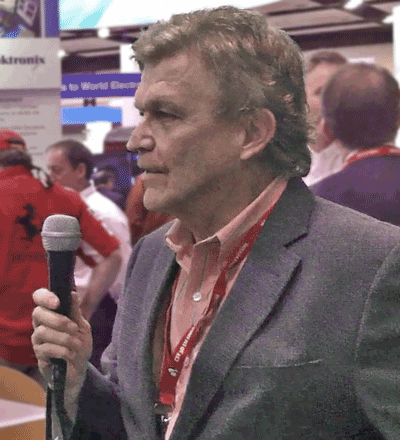He’s fascinated by all the ways electronics touches our world today
BY LEN SCHIEFER
I recently had a chance to e-mail-chat with Jim Harrison, our Technical Editor. Since he’s on the West Coast and I’m on the East, we talk on the phone all the time, but we rarely talk about how we got into this business. Here are my questions and Jim’s answers.
Len Schiefer: When did you first know you wanted to pursue a career in electrical engineering? Did you always know you wanted to be an EE?
Jim Harrison: Yes, that’s pretty much the case. I enlisted in the Navy when I was 16 so I could get electronics training and left for boot camp just two weeks after high school graduation.

After boot camp it was 70 some weeks of electronic technician school on Treasure Island in San Francisco Bay and then another 20 weeks of further school in Colorado. Between trips to sea on a destroyer tender, I went to a few different Universities and then when I got out of the Navy (That’s the way they say it — got out of. Kind like they speak of jail) I got a technician job at the University of Iowa.
Len Schiefer: Was there a particular aspect of electronics that fascinated you, and are you still fascinated with it?
Jim Harrison: I’m still fascinated with electronics, but I like working in different aspects of it — analog, digital, systems design, a bit (pardon the pun) of real-time software. Think of all the ways electronics touches our world today!
Len Schiefer: When you started working as an engineer, what sort of tasks did you do?
Jim Harrison: I got that engineer title after working at the University of Iowa for a few years. I worked at the Physics Research Center headed by Dr. James Van Allen and designed space and ground based scientific experiments. It was a great introduction to design engineering. I was lucky to have a great boss/mentor there — a guy by the name of Enemark.
Len Schiefer: What was your favorite project?
Jim Harrison: Boy, there have been a lot of great projects I have been lucky enough to be a part of. At the U. of Iowa I worked Low Energy Particle and Solar Wind Detector experiment on the Injun-Explorer 5 spacecraft.
Later I went to Lockheed Research Labs in Palo Alto and worked on the design of a gamma ray spectrometer. I spent one memorable night on top of an Atlas rocket on the launch pad at the Western Test Range in Lompoc making sure the detector got all the liquid nitrogen it needed before launch the next day. I was also the Chief Engineer at a company that did control systems for large color printing presses and the manager of component engineering for a telcom startup in Petaluma.
Len Schiefer: How and why did you make the transition from working in electronic engineering to writing for electronics engineers on Electronic Products Magazine and Hearst Electronics Group?
Jim Harrison: Well, you see, one day I was at a conference in San Jose and Mr. Murray Slovick, who was Editorial Director at EP at the time, came up to me and said “how would you like to write about technology.” It’s all Murray’s fault. I’ve been here eight years now and really like it a lot.
Len Schiefer: What sorts of things do you do in your free time?
Jim Harrison: There’s gym on 4th street a few blocks from my office that I try to get to three times a week. That’s essential for me. If I don’t get to the gym I don’t feel all that good; it’s just that simple. I ride a road bike (though this year it’s been in the garage most of the time), I like hiking at Point Reyes National Seashore — which is about 20 miles west of here. Then there’s working on my house — which I like to a certain extent. I read the San Francisco Chronicle every morning.
Len Schiefer: What advice do you have for young engineers?
Jim Harrison: Find a good mentor — a good design engineer who has been around a while and is happy to advise you. And, your very first job is really important — don’t look for salary; look for a great place to learn and great people to work with. A research environment is a good place to start — and maybe even stay. ■
Advertisement
Learn more about Electronic Products Magazine





